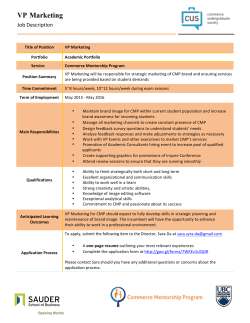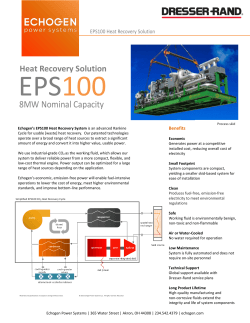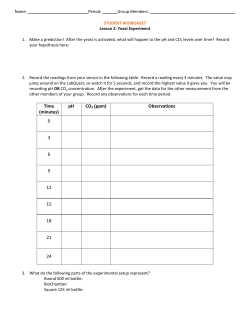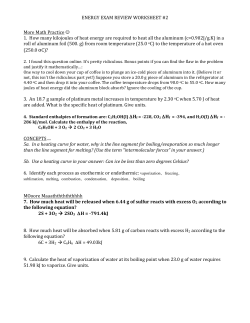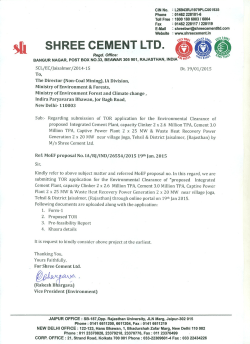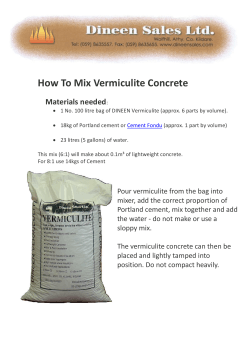
slides - organized by CO 2 GeoNet in collaboration with
ULTimateCO2: the underground rock laboratory experiment of Mont Terri Pascal Audigane BRGM – CO2GEONET 10th CO2GeoNet Open Forum, May 11-‐12 2015 – Venice, San Servolo Island ultimateco2.eu Well integrity assessment under temperature and pressure stresses by a 1:1 scale wellbore experiment Submitted in Water Resources Researches JC. Manceau, J. Trémosa, P. Audigane, F. Claret, L.J. Wasch, F. Gherardi, O. Ukelis, A. Dimier, C. Nussbaum, Y. Lettry, T. Fierz JC.MANCEAU@BRGM.FR Motivation and objective Laboratory (core scale) studies for well integrity assessment: hydraulic properties of well elements cement carbonation rates analysis casing corrosion Interface of well elements (casing – cement – rock) Field scale studies for well integrity assessment: vertical interference tests for well system equivalent permeability study on CO2 producer samples Objective of this study: evaluate the behavior of the entire well system at an 1:1 scale over time, time due to changes in well conditions: pressure, temperature and fluids in contact with the well (CO2 or not) 3 Location of the experiment Underground Rock Laboratory of Mont Terri, Switzerland [Mont Terri Project, 2014] 4 Concept 5 Concept Construct a well section 6 Concept Construct a well section Design of intervals for, under different conditions: between the intervals through the well Measuring of the flow inside and outside the casing ⇒ Sealing changes Sampling fluid regularly ⇒ Fluid composition changes Take samples of the different elements (overcoring) ⇒ Mineralogical changes 7 Method for assessing well integrity Create circulation top → bottom: Pressure difference = equivalent permeability Fluid sampling Continuous characterization of the well system over time: Period 1: Initial T (16°C), pore water composition Period 2: Increase of T (50°C), initial pore water conditions Period 3: Decrease of T (30°C), initial pore water conditions Period 4: Same T(30°C), pore water + dissolved CO2 8 A complex system System 1 3 2 4 5 10 Assessment of equivalent permeability 2D radial flow modeling (TOUGH2) Main output of interest: effective well permeability Other influential parameters to account for: Caprock permeability and pressure boundary conditions: derived from pressure relaxation tests Intervals compressibility: computed at different times from independent tests 11 Validation of the hydraulic model Data/model matching in terms of Ptop and injected volume (mass balance). Ex. period 3 (large variations of pressure) 12 Effects of temperature increase A large decrease of Keff is observed. The bottom interval is disconnected from the caprock/annulus contrary to the top interval: the Keff decrease seems to occur at the bottom (larger T increase) Rock/material expansion or geochemical precipitations or natural borehole convergence could be contemplated 13 Effect of Pbottom increase Keff dependant on Pbottom: could be a sign of flow through annuli/interfaces +8bars +4bars +3bars 14 Flow through annuli/interfaces: insights from water chemistry Solutions from intervals sampled over time Geochemical model using PhreeqC v3 which simulates the water/cement/clay interactions and the transport Solution composition in top interval could be explained by a channelized flow without passing through the cement porosity 15 Results: effects of CO2 Lower effect of pressure increase: sign of carbonation at annuli/interfaces ? +8bars +4bars +3bars +8bars +6bars 16 Conclusions Ability of the chosen design to estimate the evolution of the well integrity over time Main observations: Keff decrease with temperature increase Keff dependent on the imposed pressure Dissolved CO2 limits the pressure effects The contact between the well and CO2 is planned to last until spring 2015 Final overcoring: link these preliminary observations with mineralogical observations 17 Thank you for your attention ultimateco2.eu 18
© Copyright 2025
